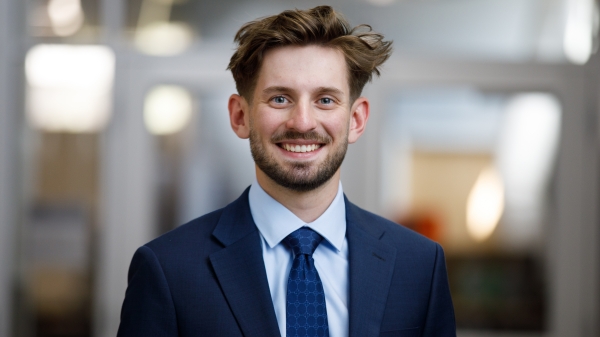ASU center elevates biophysics awareness during National Biophysics Week

Illustration courtesy the Center for Biological Physics
At the forefront of scientific discovery, the Center for Biological Physics at Arizona State University brings together experts from biology, physics, health, chemistry and engineering to advance biological physics research.
“We have the largest collection of talent at this interface of physical principles and cell biophysics, whose expertise covers a wide range of spatio-temporal length scales: spectroscopy and optics, and Bayesian and other data-driven, multi-scale methods to explore emergent phenomena in living systems,” said Banu Ozkan, the center’s director. “The questions we investigate mirror ASU’s ambition to redefine the culture of 21st-century universities, moving away from discipline-defined departments toward integrated schools focused on grand challenges.”
As part of National Biophysics Week, the center will host two premiere events: Biophysics Day on March 22 and Biophest on March 23. Both events will showcase the growing field of biological physics, address its profound impact and share the center’s research with prospective students and scientists from Arizona.
In celebration of National Biophysics Week, faculty and student researchers shared about the center’s work and impact.
Going with the flow
Professor Dmitry Matyushov, one of the founding leaders of the Center for Biological Physics, focuses his research at the intersection of theoretical and computational physics, physical chemistry and biophysics.
He currently leads the center’s Matyushov Lab, which delves into the various physical mechanisms behind energy flow. One of the lab’s primary research projects is studying electron transfer processes, which occur when an electron relocates from one molecule or atom to another.
They are researching how fast and how much energy is involved when electrons move and aim to create basic rules of how efficiently these charges can be transferred along a chain, Matyushov explained.
“Our research combines computer simulations with the development of theoretical models directly applicable to interpreting the experiment," he said.
The study of electron transfer has wide implications across scientific disciplines, from a better understanding of biological processes to discovering and developing medicines and technological innovations.
Digging deeper with data
The Pressé Lab, led by Professor Steve Pressé, bridges the interdisciplinary gaps between physics, chemistry and biology.
Collaborating with experts in biology and chemistry, the lab applies mathematical models to real-life experiments. They explore everything from the life journey of a single protein to investigating how groups of proteins regulate vital cellular events, such as cell division and organization.
Weiqing Xu, a biophysics PhD student, is a member of the Pressé Lab and is engaged in interdisciplinary research with other researchers at the center.
For young people, it’s hard to decide their future career. What I can say is that if they want to do a project where they can learn from many different fields and do active research, biophysics has that.
Weiqing XuASU biophysics PhD student
Xu’s work with the lab involves integrating mathematical models into biology and chemistry research to maximize the data collected from their experiments.
“Chemists and biologists know a lot about their systems and collect a lot of data, but they often don’t know how to extract information efficiently from that data,” Xu said. “Much of our research involves applying the rigorous mathematical models you use in physics, math or statistics to a real-life complicated system, such as a cell.
“Many labs design clever experiments. We feel like we can use our knowledge of math, physics and statistics to help them dig deeper into the data they have collected.”
'Hunting' predatory bacteria
In addition to collaborating with other researchers within the center, the Pressé Lab is currently researching three focus areas: bacterial hydrodynamic hunters, spectroscopy and imaging, and molecular motor efficiency and vesicle transport.
Their research into hydrodynamic hunters uses microscopy experiments to understand the hunting dynamics of predatory bacteria. Unlike many bacteria that obtain nutrients through passive diffusion or breaking down other organic matter, predatory bacteria actively hunt and feed on other bacteria as their energy source.
Studying predatory bacteria with microscopy experiments allows you to understand their hunting behaviors. It will expand our knowledge of microbial interactions and open up practical applications in agriculture, medicine and environmental management.
Innovative microscopy techniques
The Quantitative Imaging and Inference Lab, led by Assistant Professor Douglas Shepherd, seeks to understand how molecular and cellular biology evolved to exploit the laws of the natural world. The group members include physicists, biochemists and biologists.
To better understand the natural world, the lab builds and invents cutting-edge microscopy techniques that provide unique views into the interplay of physics and molecular biology.
Peter Brown, a postdoctoral research scholar in the lab, recently had his work on super-resolution microscopy recognized with an honorable mention for best paper in Biomedical Optics Express.
In addition to fundamental studies on the interaction of physics and molecular biology, the lab also studies human tissue organization. As part of two major international consortiums, the team is working to build the next generation of cell atlases to power biomedical research. Currently, the team focuses on generating the first detailed molecular map of the human olfactory bulb, which relays information from your nose to the rest of your brain.
More Science and technology

Cracking the code of online computer science clubs
Experts believe that involvement in college clubs and organizations increases student retention and helps learners build valuable social relationships. There are tons of such clubs on ASU's campuses…
Consortium for Science, Policy & Outcomes celebrates 25 years
For Arizona State University's Consortium for Science, Policy & Outcomes (CSPO), recognizing the past is just as important as designing the future. The consortium marked 25 years in Washington, D…

Hacking satellites to fix our oceans and shoot for the stars
By Preesha KumarFrom memory foam mattresses to the camera and GPS navigation on our phones, technology that was developed for space applications enhances our everyday lives on Earth. In fact, Chris…